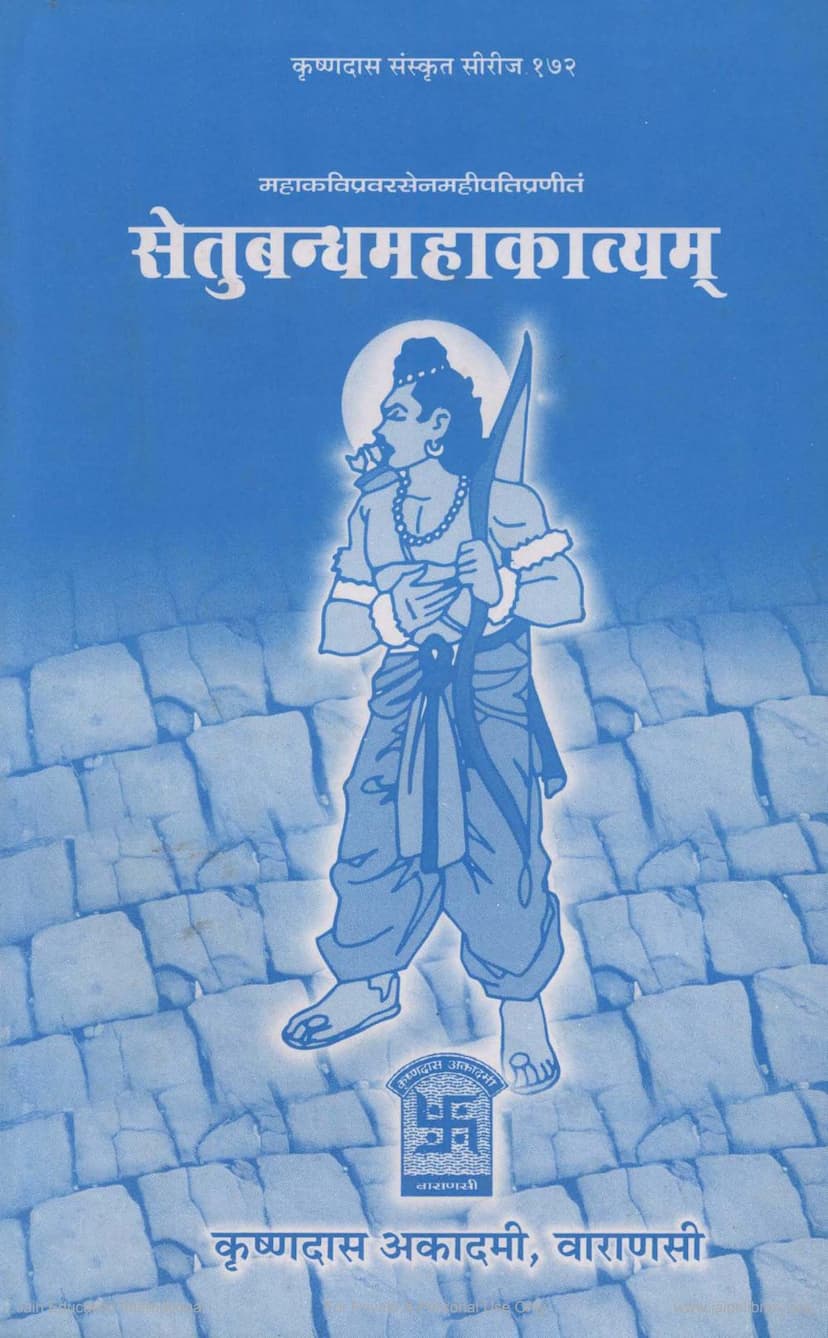Setubandhmahakavyam
Added to library: September 2, 2025

Summary
This is a comprehensive summary of the Jain text "Setubandhmahakavyam" by Pravarsena, with commentary by Ramnath Tripathi Shastri, published by Krishnadas Academy Varanasi, based on the provided pages:
Book Title: Setubandhmahakavyam (also known as Dashamukhavadham)
Author: Mahakavi Pravarsena (King)
Commentary (Sanskrit): Ramasetupradipa by Sri Ramadas Bhupati
Commentary (Hindi): Vimala by Pt. Ramnath Tripathi Shastri
Publisher: Krishnadas Academy, Varanasi
Overview:
The Setubandhmahakavyam is a significant Mahakavya (epic poem) written in Prakrit by King Pravarsena. It narrates the story of Lord Rama's epic journey to Lanka, his construction of the Setu (bridge) across the ocean, and his eventual victory over Ravana. The work is celebrated for its poetic brilliance, rich descriptions, and sophisticated use of language.
Key Aspects and Summary of the Provided Pages:
The provided pages primarily focus on the introduction, publisher's details, dedication, foreword by the commentator (Pt. Ramnath Tripathi Shastri), and the introduction (Bhumika) to the work itself.
-
Publisher and Edition: Krishnadas Academy, Varanasi, published the first edition in Vikram Samvat 2058 (2002 CE). The ISBN is provided as 81-218-0089-7. The text is presented with both a Sanskrit commentary ('Ramasetupradipa' by Sri Ramadas Bhupati) and a Hindi commentary ('Vimala' by Pt. Ramnath Tripathi Shastri), highlighting its accessibility to a wider audience.
-
Dedication: The book is dedicated to the memory of the publisher's mother, Sarayu Devi.
-
Foreword by Pt. Ramnath Tripathi Shastri:
- The foreword emphasizes the importance of translating and presenting significant Sanskrit works in Hindi to enrich the national language.
- He expresses gratitude to Sri Ramadas Bhupati for his Sanskrit commentary, which illuminated difficult passages.
- He thanks his son, Vedprakash Dwivedi 'Prakash', for his assistance in preparing the manuscript, and Dr. Ramakant Tripathi for writing the introduction.
- The commentator hopes his Hindi translation will contribute to the flow of cultural thought in Hindi and satisfy its readers.
- He also expresses gratitude to the publishers (Chowkhamba Sanskrit Series Office) for making the work accessible despite difficulties.
-
Introduction (Bhumika) by Dr. Ramakant Tripathi:
- Title: The work is known by two names: 'Ravana Vadh' or 'Dashamukhavadh' (because these names are specified at the end of the work and its chapters) and 'Setubandh', as mentioned by Acharya Dandin in his 'Kavyadarsh'.
- Authorship Debate: The introduction addresses a significant scholarly debate regarding the authorship of the Setubandha.
- First View (Pravasena): This view is supported by evidence from authors like Banabhatta (in Harshacharita) and Kshemendera (in Auchityavicharcharcha).
- Second View (Kalidasa for Pravasena): This view is supported by the commentator of 'Ramasetupradipa' (Ramadas Bhupati), who suggests Kalidasa composed it for King Pravarsena, under the patronage of King Vikramaditya. However, the introduction casts doubt on this theory, citing issues with the chronological placement of authors and the lack of mention of Kalidasa or the Setubandha in Kalidasa's works if he were the author.
- Historical Context of Pravasena: The introduction delves into the historical figures named Pravarsena, discussing both Kashmiri kings mentioned by Kalhana in the Rajatarangini and the Vakataka dynasty rulers. It analyzes the possible timelines and their association with Vikramaditya, ultimately concluding that the authorship remains debated.
- Vakataka Connection: The introduction proposes a connection to the Vakataka ruler Pravarsena II (also known as Damodarasena), suggesting he might have been the author, or that Kalidasa might have composed it for him. However, it reiterates the lack of definitive proof for either claim.
- Literary Merit: The introduction highlights Setubandha as an excellent Mahakavya in Prakrit, rich in all poetic elements. It notes that Sanskrit Mahakavyas are typically divided into Sargas (cantos), while Prakrit Mahakavyas are divided into Ashvasas (intervals), and that the meters used (Skandhaka or Galitaka) are consistent with ancient traditions.
- Thematic Elements: The Setubandha's protagonist is Rama, an avatar of Vishnu. The primary Rasa (sentiment) is Virarasa (heroism), with other Rasas playing secondary roles. The plot centers on Rama's life, particularly the famous events of building the Setu, crossing the ocean, defeating Ravana, and rescuing Sita.
- Poetic Devices and Purpose: The introduction mentions the poet's adherence to Bharata's definition of a Mahakavya, starting with auspicious invocations and indicating the subject matter. It also touches upon the traditional purposes of poetry (Kavya Prayojana) as outlined by Mammața, noting that the author of Setubandha himself mentions specific goals like knowledge enhancement and acquiring virtues.
- Descriptive Richness: The introduction praises the descriptions of various elements within the work, such as travel, mountains (Vindhyagiri, Sahyadri, Suvelagiri), the ocean, different times of day (morning, evening), seasons (Sharad), and particularly the detailed and unique description of Sharad Ritu, which is considered exceptional for its originality and evocative imagery. The example of the rainbow's description is given to illustrate the poet's skill in using natural phenomena metaphorically.
- Use of Language: The text is noted for its poetic qualities, employing Madhurya guna (sweetness) for descriptions of romance and separation, and Ojas guna (vigor) for heroic and furious sentiments, with Prasad guna (clarity) pervading the entire work.
Overall Impression:
The provided pages establish the Setubandhmahakavyam as a work of great literary and cultural significance. The foreword and introduction highlight the collaborative effort in bringing this ancient text to a modern audience, emphasizing its aesthetic beauty and the enduring debate surrounding its authorship, which adds to its mystique. The detailed analysis of the text's themes, descriptions, and language by the introducer signifies its depth and importance within Indian literary tradition.